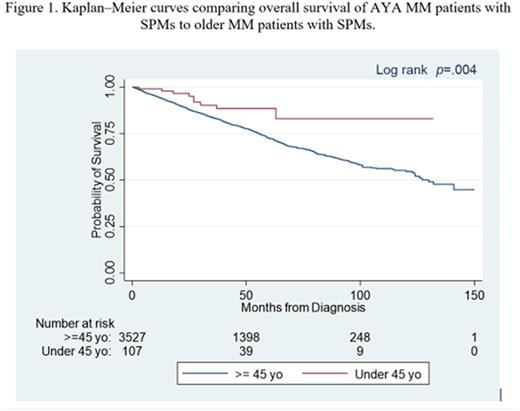Abstract
Background: Adolescents and young adults (AYAs) represent less than 5% of patients with newly diagnosed multiple myeloma (MM). Definitive guidance on treatment of AYA MM, in particular the use of high dose melphalan and autologous stem cell transplant (ASCT), is non-existent and largely extrapolated from data dealing with relatively older adult MM patients. AYA MM patients are at higher risk of underlying germline cancer predisposition (Thibaud, Blood, 2021), and live longer than adult MM patients (on average 15 years; Gibson, Blood, 2020), and hence may be at increased risk of developing a second primary malignancy (SPM). The purpose of this analysis is to utilize real-world data to better understand risks and outcomes of AYA MM patients with SPMs as compared with older adult MM patients.
Methods: The CancerLinQ registry is a subsidiary of the American Society of Clinical Oncology (ASCO) that launched in 2014 and includes real-world data from over 100 oncology practices and hospitals in the United States. Inclusion criteria were patients confirmed to have MM (ICD-9 and -10 codes 203.0 and C90.0, respectively) and who were diagnosed with MM in the modern treatment era (i.e. 2009 and later). ICD-9 and ICD-10 codes were utilized to identify the most frequently occurring SPMs and compare incidence and outcomes in AYA MM patients (defined as age <45 years at diagnosis) with MM patients age 45 years and older at diagnosis. Analyses were conducted with STATA Version 17.0 (College Station, TX); critical alpha level was set at .05. Kaplan-Meier curves were generated to demonstrate overall survival (OS).
Results: Within the CancerLinQ MM registry, 34,234 patients met inclusion criteria, of whom 1,173 (3.43%) were AYAs. The top 10 SPMs as well as chronic lymphocytic leukemia (CLL) include acute lymphoblastic lymphoma (ALL), acute myeloid leukemia (AML), breast cancer, colorectal cancer, diffuse large B cell lymphoma (DLBCL), non-melanoma skin cancer (squamous cell and basal cell carcinomas), lung cancer, melanoma, non-Hodgkin lymphoma (NHL), and prostate cancer. The incidence of one or more these SPMs among AYAs and those ≥ 45 years was 9.12% and 10.67%, respectively (p=0.09). Compared with relatively older adult MM patients ≥ 45 years, AYA MM patients were significantly more likely to develop ALL (RR 3.7, p<0.001, 95% CI 2.35-5.93), AML (RR 1.8, p=0.01, 95% CI 1.15-2.96), and NHL (RR 1.5, p=0.03, 95% CI 1.03-2.04), and were less likely to develop non-melanoma skin cancer (RR 0.2, p<0.001, 95% CI 0.08-0.45) and prostate cancer (RR 0.1, p=0.007, 95% CI 0.01-0.48). There were no statistically significant differences in breast cancer, CLL, colorectal cancer, DLBCL, lung cancer, or melanoma between MM patients who were AYAs at diagnosis and those who were ≥ 45 years at diagnosis. In terms of prognosis, AYA MM patients with SPMs lived longer than MM patients ≥ 45 years old with SPMs (HR 0.41; median OS not reached vs. 130 months) (Figure 1).
Discussion: Despite AYA MM patients being at higher risk of having germline cancer predisposition and living longer than older adult MM patients, they are not at a statistically significant increased risk of developing any SPM compared with older MM patients. However, they are at a significantly increased risk of developing hematologic neoplasms (ALL, AML, and NHL), and a significantly decreased risk of developing non-melanoma skin cancer and prostate cancer. Notably, the risk of AML in AYA MM patients was 80% higher than in older MM patients. In the absence of a survival benefit to ASCT in the modern treatment era, and given that high dose melphalan conditioning for ASCT can induce mutagenesis and heighten the risk of AML (Maura, Nature, 2021), this finding highlights the increased risk of AML in AYA MM patients and suggests that perhaps up-front ASCT could be deferred in this specific population. Despite having SPMs, AYA MM patients had an excellent prognosis, with median long-term survival not reached.
Disclosure: The findings and opinions contained herein are those of the authors and do not represent the views/opinions of the United States Air Force, United States Navy, Walter Reed National Military Medical Center, or the Department of Defense.
Disclosures
Thornton:Douglas Lane & Associates: Other: NA - DL&A are an investment advisor registered with the SEC.
Author notes
Asterisk with author names denotes non-ASH members.


This feature is available to Subscribers Only
Sign In or Create an Account Close Modal